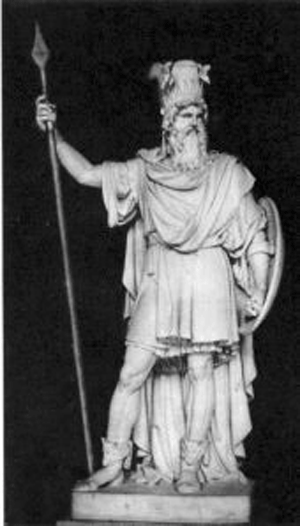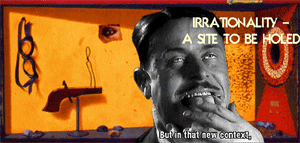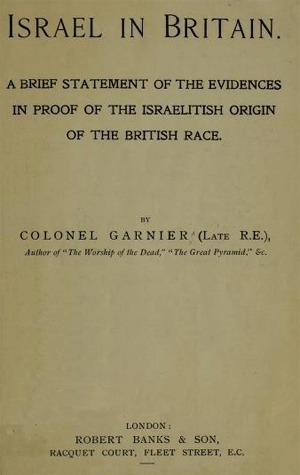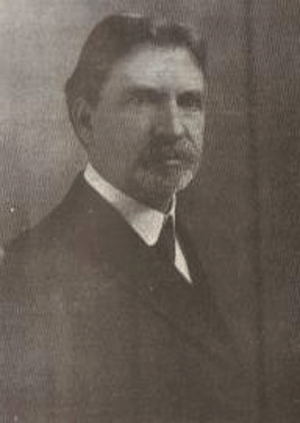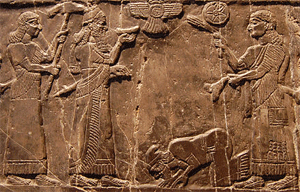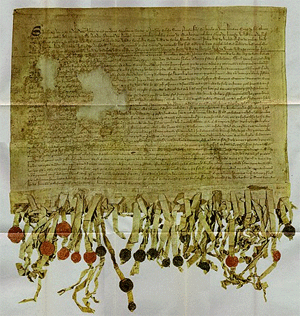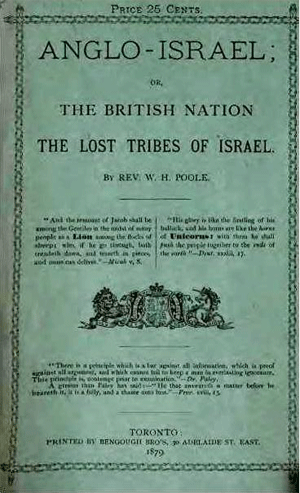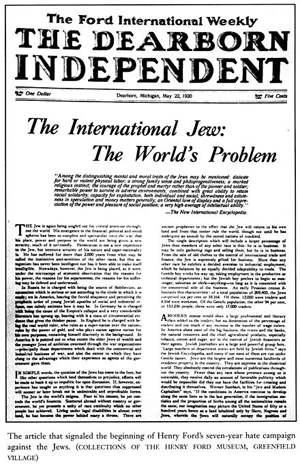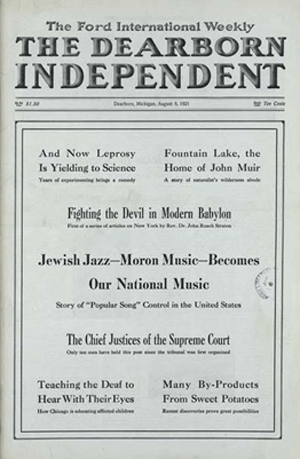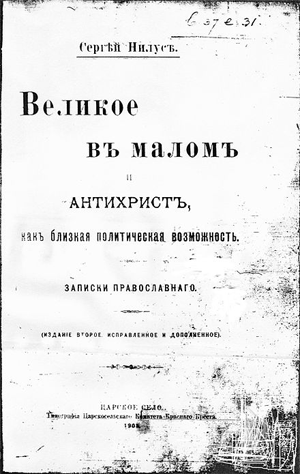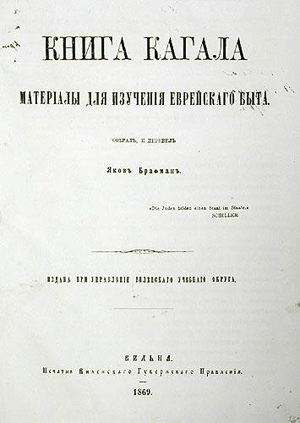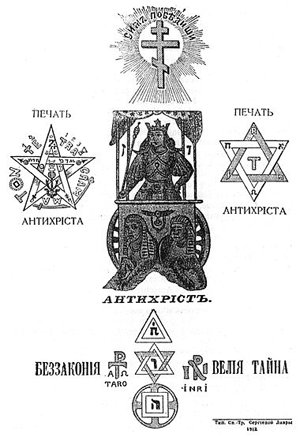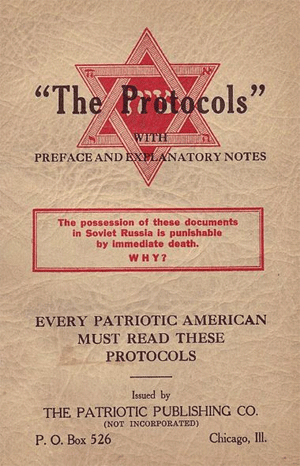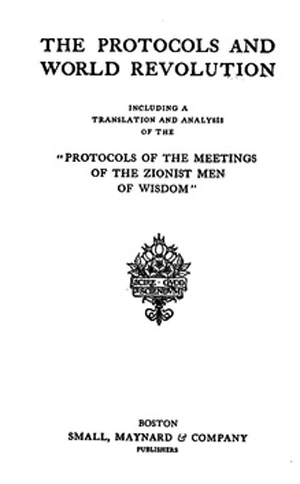Part 2 of 2
The Times exposes a forgery, 1921 The Times exposed the Protocols as a forgery on August 16–18, 1921
The Times exposed the Protocols as a forgery on August 16–18, 1921In 1920–1921, the history of the concepts found in the Protocols was traced back to the works of Goedsche and Jacques Crétineau-Joly by Lucien Wolf (an English Jewish journalist), and published in London in August 1921. But a dramatic exposé occurred in the series of articles in The Times by its Constantinople reporter, Philip Graves, who discovered the plagiarism from the work of Maurice Joly.[20]
According to writer Peter Grose, Allen Dulles, who was in Constantinople developing relationships in post-Ottoman political structures, discovered "the source" of the documentation and ultimately provided him to The Times. Grose writes that The Times extended a loan to the source, a Russian émigré who refused to be identified, with the understanding the loan would not be repaid.[65] Colin Holmes, a lecturer in economic history at Sheffield University, identified the émigré as Michael Raslovleff, a self-identified antisemite, who gave the information to Graves so as not to "give a weapon of any kind to the Jews, whose friend I have never been."[66]
In the first article of Graves' series, titled "A Literary Forgery", the editors of The Times wrote, "our Constantinople Correspondent presents for the first time conclusive proof that the document is in the main a clumsy plagiarism. He has forwarded us a copy of the French book from which the plagiarism is made."[20] In the same year, an entire book[67] documenting the hoax was published in the United States by Herman Bernstein. Despite this widespread and extensive debunking, the Protocols continued to be regarded as important factual evidence by antisemites. Dulles, a successful lawyer and career diplomat, attempted to persuade the US State Department to publicly denounce the forgery, but without success.[68]
Arab worldA translation made by an Arab Christian appeared in Cairo in 1927 or 1928, this time as a book. The first translation by an Arab Muslim was also published in Cairo, but only in 1951.[69]
Switzerland
The Berne Trial, 1934–35The selling of the Protocols (edited by German antisemite Theodor Fritsch) by the National Front during a political manifestation in the Casino of Berne on June 13, 1933,[d] led to the Berne Trial in the Amtsgericht (district court) of Berne, the capital of Switzerland, on October 29, 1934. The plaintiffs (the Swiss Jewish Association and the Jewish Community of Berne) were represented by Hans Matti and Georges Brunschvig, helped by Emil Raas. Working on behalf of the defense was German antisemitic propagandist Ulrich Fleischhauer. On May 19, 1935, two defendants (Theodore Fischer and Silvio Schnell) were convicted of violating a Bernese statute prohibiting the distribution of "immoral, obscene or brutalizing" texts[70] while three other defendants were acquitted. The court declared the Protocols to be forgeries, plagiarisms, and obscene literature. Judge Walter Meyer, a Christian who had not heard of the Protocols earlier, said in conclusion,
I hope the time will come when nobody will be able to understand how in 1935 nearly a dozen sane and responsible men were able for two weeks to mock the intellect of the Bern court discussing the authenticity of the so-called Protocols, the very Protocols that, harmful as they have been and will be, are nothing but laughable nonsense.[42]
Vladimir Burtsev, a Russian émigré, anti-Bolshevik and anti-Fascist who exposed numerous Okhrana agents provocateurs in the early 1900s, served as a witness at the Berne Trial. In 1938 in Paris he published a book, The Protocols of the Elders of Zion: A Proved Forgery, based on his testimony.
On November 1, 1937, the defendants appealed the verdict to the Obergericht (Cantonal Supreme Court) of Berne. A panel of three judges acquitted them, holding that the Protocols, while false, did not violate the statute at issue because they were "political publications" and not "immoral (obscene) publications (Schundliteratur)" in the strict sense of the law.[70] The presiding judge's opinion stated, though, that the forgery of the Protocols was not questionable and expressed regret that the law did not provide adequate protection for Jews from this sort of literature. The court refused to impose the fees of defense of the acquitted defendants to the plaintiffs, and the acquitted Theodor Fischer had to pay 100 Fr. to the total state costs of the trial (Fr. 28'000) that were eventually paid by the Canton of Berne.[71] This decision gave grounds for later allegations that the appeal court "confirmed authenticity of the Protocols" which is contrary to the facts. A view favorable to the pro-Nazi defendants is reported in an appendix to Leslie Fry's Waters Flowing Eastward.[72] A more scholarly work on the trial is in a 139-page monograph by Urs Lüthi.[73]
The Basel TrialA similar trial in Switzerland took place at Basel. The Swiss Frontists Alfred Zander and Eduard Rüegsegger distributed the Protocols (edited by the German Gottfried zur Beek) in Switzerland. Jules Dreyfus-Brodsky and Marcus Cohen sued them for insult to Jewish honor. At the same time, chief rabbi Marcus Ehrenpreis of Stockholm (who also witnessed at the Berne Trial) sued Alfred Zander who contended that Ehrenpreis himself had said that the Protocols were authentic (referring to the foreword of the edition of the Protocols by the German antisemite Theodor Fritsch). On June 5, 1936 these proceedings ended with a settlement.[e]
GermanyAccording to historian Norman Cohn,[75] the assassins of German Jewish politician Walter Rathenau (1867–1922) were convinced that Rathenau was a literal "Elder of Zion".
It seems likely Hitler first became aware of the Protocols after hearing about it from ethnic German white émigrés, such as Alfred Rosenberg and Max Erwin von Scheubner-Richter.[76] Hitler refers to the Protocols in Mein Kampf:
... [The Protocols] are based on a forgery, the Frankfurter Zeitung moans [ ] every week ... [which is] the best proof that they are authentic ... the important thing is that with positively terrifying certainty they reveal the nature and activity of the Jewish people and expose their inner contexts as well as their ultimate final aims.[77]
The Protocols also became a part of the Nazi propaganda effort to justify persecution of the Jews. In The Holocaust: The Destruction of European Jewry 1933–1945, Nora Levin states that "Hitler used the Protocols as a manual in his war to exterminate the Jews":
Despite conclusive proof that the Protocols were a gross forgery, they had sensational popularity and large sales in the 1920s and 1930s. They were translated into every language of Europe and sold widely in Arab lands, the US, and England. But it was in Germany after World War I that they had their greatest success. There they were used to explain all of the disasters that had befallen the country: the defeat in the war, the hunger, the destructive inflation.[78]
Hitler endorsed the Protocols in his speeches from August 1921 on, and it was studied in German classrooms after the Nazis came to power. "Distillations of the text appeared in German classrooms, indoctrinated the Hitler Youth, and invaded the USSR along with German soldiers."[1] Nazi Propaganda Minister Joseph Goebbels proclaimed: "The Zionist Protocols are as up-to-date today as they were the day they were first published."[79]
In contrast to Hitler, Nazi leader Erich von dem Bach-Zelewsky admitted:
I am the only living witness but I must say the truth. Contrary to the opinion of the National Socialists, that the Jews were a highly organized group, the appalling fact was that they had no organization whatsoever. The mass of the Jewish people were taken complete by surprise. They did not know at all what to do; they had no directives or slogans as to how they should act. This is the greatest lie of anti-Semitism because it gives the lie to that old slogan that the Jews are conspiring to dominate the world and that they are so highly organized. In reality, they had no organization of their own at all, not even an information service. If they had had some sort of organization, these people could have been saved by the millions, but instead, they were taken completely by surprise. Never before has a people gone as unsuspectingly to its disaster. Nothing was prepared. Absolutely nothing.[80][81]
Richard S. Levy criticizes the claim that the Protocols had a large effect on Hitler's thinking, writing that it is based mostly on suspect testimony and lacks hard evidence.[40]
Publication of the Protocols was stopped in Germany in 1939 for unknown reasons.[82] An edition that was ready for printing was blocked by censorship laws.[83]
German language publicationsHaving fled Ukraine in 1918–19, Piotr Shabelsky-Bork brought the Protocols to Ludwig Muller Von Hausen who then published them in German.[84] Under the pseudonym Gottfried Zur Beek he produced the first and "by far the most important"[85] German translation. It appeared in January 1920 as a part of a larger antisemitic tract[86] dated 1919. After The Times discussed the book respectfully in May 1920 it became a bestseller. "The Hohenzollern family helped defray the publication costs, and Kaiser Wilhelm II had portions of the book read out aloud to dinner guests".[79] Alfred Rosenberg's 1923 edition[87] "gave a forgery a huge boost".[79]
ItalyFascist politician Giovanni Preziosi published the first Italian edition of the Protocols in 1921.[88][page needed] The book however had little impact until the mid-1930s. A new 1937 edition had a much higher impact, and three further editions in the following months sold 60,000 copies total.[88][page needed] The fifth edition had an introduction by Julius Evola, which argued around the issue of forgery, stating: "The problem of the authenticity of this document is secondary and has to be replaced by the much more serious and essential problem of its truthfulness".[88][page needed]
Modern eraThe Protocols continue to be widely available around the world, particularly on the Internet, as well as in print in Japan, the Middle East, Asia, and South America.[89]
Governments or political leaders in most parts of the world have not referred to the Protocols since World War II. The exception to this is the Middle East, where a large number of Arab and Muslim regimes and leaders have endorsed them as authentic, including endorsements from Presidents Gamal Abdel Nasser and Anwar Sadat of Egypt, the elder President Arif of Iraq,[90] King Faisal of Saudi Arabia, and Colonel Muammar al-Gaddafi of Libya.[69][91]
The 1988 charter of Hamas, a Palestinian Islamist group, states that The Protocols of the Elders of Zion embodies the plan of the Zionists.[92] Recent endorsements in the 21st century have been made by the Grand Mufti of Jerusalem, Sheikh Ekrima Sa'id Sabri, the education ministry of Saudi Arabia,[91] member of the Greek Parliament Ilias Kasidiaris,[93] and Young Earth creationist and tax evader Kent Hovind.[94]
See alsoPertinent concepts
• Black propaganda
• Blood libel
• Disinformation
• Hate speech
• World government
Individuals• Martin Heidegger and Nazism
Related or similar texts• A Racial Program for the Twentieth Century
• Alta Vendita
• Tanaka Memorial
• Protocols of Zion
• Hamas Covenant
• The Prague Cemetery
• Memoirs of Mr. Hempher, The British Spy to the Middle East
• Warrant for Genocide
Notes1. The text contains 44 instances of the word "I" (9.6%), and 412 instances of the word "we" (90.4%).[14]
2. This complex relationship was originally exposed by Graves 1921. The exposé has since been elaborated in many sources.
3. Jacobs analyses the Marsden English translation. Some other less common imprints have more or fewer than 24 protocols
4. The main speaker was the former chief of the Swiss General Staff Emil Sonderegger.
5. Zander had to withdraw his contention and the stock of the incriminated Protocolswere destroyed by order of the court. Zander had to pay the fees of this Basel Trial.[74]
References1. Segel, BW and Levy, RS. A Lie and a Libel: The History of the Protocols of the Elders of Zion. University of Nebraska Press (1995), p. 30. ISBN 0803242433,
2. Michelis, Cesare G. De (2004). The non-existent manuscript : a study of the Protocols of the sages of Zion. Lincoln: Univ. of Nebraska Press. p. 65. ISBN 0803217277.
3. Michelis, Cesare G. De (2004). The non-existent manuscript : a study of the Protocols of the sages of Zion. Lincoln: Univ. of Nebraska Press. pp. 76–80. ISBN 0803217277.
4. Webman 2012, p. 60.
5. Donskis, Leonidas (2003-01-01). Forms of Hatred: The Troubled Imagination in Modern Philosophy and Literature. Rodopi. ISBN 9042010665.
6. "Ritual murder encouraged..." New York Times. August 27, 1911.
7. "Non-Existent Manuscript - University of Nebraska Press".
http://www.nebraskapress.unl.edu. Retrieved 2015-11-22.
8. Jacobs & Weitzman 2003, p. 15.
9. Segel, Binjamin W (1996) [1926], Levy, Richard S, ed., A Lie and a Libel: The History of the Protocols of the Elders of Zion, University of Nebraska Press, p. 97, ISBN 0-8032-9245-7.
10. De Michelis 2004, p. 47.
11. De Michelis 2004, p. 114].
12. A Hoax of Hate, Jewish Virtual Library.
13. Boym, Svetlana (1999), "Conspiracy theories and literary ethics: Umberto Eco, Danilo Kis and 'The Protocols of Zion'", Comparative Literature, 51 (Spring): 97, doi:10.2307/1771244.
14. The Protocols of the Learned Elders of Zion, Marsden, VE transl, Shoah education.
15. Pipes 1997, p. 85.
16. Ye’r, Bat; Kochan, Miriam; Littman, David (December 1, 2001), Islam and Dhimmitude, US: Fairleigh Dickinson University Press, p. 142, ISBN 978-0-8386-3942-9.
17. Eco, Umberto (1994), "Fictional Protocols", Six Walks in the Fictional Woods, Cambridge, MA: Harvard University Press, p. 135, ISBN 0-674-81050-3
18. De Michelis, Newhouse & Bi-Yerushalayim 2004, p. 8.
19. Bein, Alex (1990), The Jewish question: biography of a world problem, Fairleigh Dickinson Univ Press, p. 339, ISBN 978-0-8386-3252-9
20. Graves 1921.
21. Keren, David (February 10, 1993), Commentary on The Protocols of the Elders of Zion (PDF), IGC, p. 4, archived from the original (PDF) on July 29, 2014. Republished as "Introduction", The Protocols of the Learned Elders of Zion, Marsden, Victor E transl.
22. Cohn, Norman (1966), Warrant for Genocide: The Myth of the Jewish World-Conspiracy and the Protocols of the Elder of Zion, New York: Harper & Row, pp. 32–36.
23. Eco, Umberto (1998), Serendipities: Language and Lunacy, New York: Columbia University Press, p. 14, ISBN 0-231-11134-7
24. Olender, Maurice (2009), Race and Erudition, Harvard University Press, p. 11.
25. Mendes-Flohr, Paul R; Reinharz, Jehuda (1995), The Jew in the Modern World: A Documentary History, p.363 see footnote, ISBN 0-19-507453-X
26. Chanes 2004, p. 58.
27. Shibuya 2007, p. 571.
28. Jacobs & Weitzman 2003, pp. 21–25.
29. de Michelis, Newhouse & Bi-Yerushalayim 2004.
30. Cohn 1967.
31. Eco, Umberto (1990), Foucault's Pendulum, London: Picador, p. 490.
32. Pipes 1997, pp. 86–87.
33. Freund, Charles Paul (February 2000), "Forging Protocols", Reason Magazine.
34. "Princess Radziwill Quizzed at Lecture; Stranger Questions Her Title After She Had Told of Forgery of "Jewish Protocols." Creates Stir at Astor Leaves Without Giving His Name— Mrs. Huribut Corroborates the Princess. Stranger Quizzes Princess. Corroborates Mme. Radziwill. Never Reached Alexander III. The Corroboration. Says Orgewsky Was Proud of Work". The New York Times. March 4, 1921. Retrieved 2008-08-05.
35. Conan, Éric (November 16, 1999), "Les secrets d'une manipulation antisémite"[The secrets of an antisemite manipulation], L’Express (in French).
36. Skuratovsky, Vadim (2001), The Question of the Authorship of "The Protocols of the Elders of Zion", Kiev: Judaica Institute, ISBN 966-7273-12-1.
37. Bronner 2003, p. ix, 56.
38. M. Hagemeister. The Non-Existent Manuscript. pp. passim.
39. Michael Hagemeister (2008). "The Protocols of the Elders of Zion: Between History and Fiction". New German Critique 103. 35 (1): 83–95. How can we explain that when it comes to the origins and dissemination of the Protocols of the Elders of Zion, the rules of careful historical research are so completely ignored and we are regularly served up stories
40. Richard S. Levy (2014). "Setting the Record Straight Regarding The Protocols of the Elders of Zion: A Fool's Errand?". In William C. Donahue and Martha B. Helfer. Nexus — Essays in German Jewish Studies. 2. Camden House. pp. 43–61.
41. Karasova, T; Chernyakhovsky, D, Afterword (in Russian) in Cohn, Norman, Warrant for Genocide (in Russian) (translated ed.).
42. Kadzhaya, Valery. "The Fraud of a Century, or a book born in hell". Archived from the original on December 17, 2005. Retrieved September 2005. Check date values in: |accessdate= (help).
43. Kominsky, Morris (1970), The Hoaxers, p. 209, ISBN 0-8283-1288-5.
44. Fyodorov, Boris, P. Stolypin's attempt to resolve the Jewish question (in Russian), RU.
45. Burtsev, Vladimir (1938), "4", The Protocols of the Elders of Zion: A Proved Forgery(in Russian), Paris: Jewniverse, p. 106.
46. Baldwin, N. Henry Ford and the Jews. The mass production of hate. PublicAffair (2001), p. 82. ISBN 1891620525.
47. Wallace, M. The American axis: Henry Ford, Charles Lindbergh, and the rise of the Third Reich. St. Martin's Press (2003), p. 60. ISBN 0312290225.
48. Singerman 1980, pp. 48–78.
49. Toczek, Nick (2015). Haters, Baiters and Would-Be Dictators: Anti-Semitism and the UK Far Right. Routledge. ISBN 1317525876.
50. Rivera, David Allen (1998) [1994], "5", Final Warning: A History of The New World Order.
51. Handwerk, Brian (September 11, 2006), "Anti-Semitic "Protocols of Zion" Endure, Despite Debunking", National Geographic News.
52. "Protocols of the Elders of Zion", Holocaust Encyclopedia, US: Holocaust Memorial Museum, May 4, 2009.
53. David 2000.
54. Carroll 2006.
55. Jenkins, Philip (1997), Hoods and Shirts: The Extreme Right in Pennsylvania, 1925–1950, UNC Press, p. 114, ISBN 0-8078-2316-3
56. Steed, Henry Wickham (May 8, 1920), "A Disturbing Pamphlet: A Call for Enquiry", The Times.
57. Friedländer, Saul (1997), Nazi Germany and the Jews, New York: HarperCollins, p. 95.
58. Liebich, A. The Antisemitism of Henry Wickham Steed. Patterns of Prejudice Volume 46, Issue 2, 2012. Retrieved May 21, 2015.
59. Szczesny, Joseph (27 May 2014). "Home Could Henry Ford Have Dreamed a Jew Would Run His Car Company?". Forward. Retrieved 25 September 2017.
60. "Henry Ford publishes the last issue of the Dearborn Independent". History.com. Retrieved 25 September 2017.
61. Wallace, Max (2003), The American Axis, St. Martin's Press.
62. Rosenbaum, Robert A (2010). Waking to Danger: Americans and Nazi Germany, 1933-1941. Greenwood Press. p. 41. ISBN 978-0313385025.
63. Dobbs, Michael (November 30, 1998), "Ford and GM Scrutinized for Alleged Nazi Collaboration", The Washington Post, p. A01, retrieved March 20, 2006.
64. Marsden, Victor E, "Introduction", The protocols of the learned Elders of Zion (English ed.).
65. Grose, Peter (1994), Gentleman Spy: The Life of Allen Dulles, Houghton Mifflin.
66. Poliakov, Leon (1997), "Protocols of the Learned Elders of Zion", in Roth, Cecil, Encyclopedia Judaica (CD-ROM 1.0 ed.), Keter, ISBN 965-07-0665-8.
67. Bernstein 1921.
68. Richard Breitman et al. (2005). OSS Knowledge of the Holocaust. In: U.S. Intelligence and the Nazis. pp. 11-44. [Online]. Cambridge: Cambridge University Press. Available from: Cambridge Books Online doi:10.1017/CBO9780511618178.006 [Accessed 20 April 2016]. page 25
69. Lewis, Bernard (1986), Semites and Anti-Semites: An Inquiry into Conflict and Prejudice, WW Norton & Co., p. 199, ISBN 0-393-02314-1
70. Hafner, Urs (December 23, 2005). "Die Quelle allen Übels? Wie ein Berner Gericht 1935 gegen antisemitische Verschwörungsphantasien vorging" (in German). Neue Zürcher Zeitung. Archived from the original on February 1, 2011. Retrieved 2008-10-11.
71. Ben-Itto 2005, chapter 11.
72. Fry, Leslie. "Appendix II: The Berne Trials". Waters Flowing Eastward. Retrieved 2009-08-11.
73. Lüthi, Urs (1992), Der Mythos von der Weltverschwörung: die Hetze der Schweizer Frontisten gegen Juden und Freimaurer, am Beispiel des Berner Prozesses um die "Protokolle der Weisen von Zion" (in German), Basel/Frankfurt am Main: Helbing & Lichtenhahn, ISBN 978-3-7190-1197-0, OCLC 30002662
74. Lüthi 1992, p. 45.
75. Cohn 1967, p. 169.
76. Gellately, Robert (2012). Lenin, Stalin and Hitler: The Age of Social Catastrophe, ISBN 1448138787, p. 99
77. Hitler, Adolf, "XI: Nation and Race", Mein Kampf, I, pp. 307–8.
78. Nora Levin, The Holocaust: The Destruction of European Jewry 1933–1945. Quoting from IGC.org[permanent dead link]
79. Pipes 1997, p. 95.
80. Nora Levin (1968). The holocaust: the destruction of European Jewry, 1933-1945. T. Y. Crowell Co. p. 20.
81. Joel E. Dimsdale (January 1, 1980). Survivors, Victims, and Perpetrators: Essays on the Nazi Holocaust. Taylor & Francis. p. 35. ISBN 978-0-89116-351-0.
82. Michael Hagemeister (2011). "The Protocols of the Elders of Zion in court: The Bern trials, 1933-1937". In Esther Webman. The Global Impact of 'The Protocols of the Elders of Zion'. London, New York: Routledge. pp. 241–253.
83. Michael Hagemeister, lecture at Cambridge University, 11 November 2014. video
84. Kellogg 2005, pp. 63–65.
85. Pipes 1997, p. 94.
86. Geheimnisse der Weisen von Zion (in German), Auf Vorposten, 1919.
87. Rosenberg, Alfred (1923), Die Protokolle der Weisen von Zion und die jüdische Weltpolitik, Munich: Deutscher Volksverlag.
88. Valentina Pisanty (2006), La difesa della razza: Antologia 1938-1943, Bompiani
89. Jacobs & Weitzmann 2003, pp. xi–xiv, 1–4.
90. Katz, S. and Gilman, S. Anti-Semitism in Times of Crisis. NYU Press (1993), pp. 344-5. ISBN 0814730566
91. Islamic Antisemitism in Historical Perspective (PDF), Anti-Defamation League, pp. 8–9, archived from the original (PDF) on 2003-07-05
92. "Hamas Covenant". Yale. 1988. Retrieved May 27, 2010. Today it is Palestine, tomorrow it will be one country or another. The Zionist plan is limitless. After Palestine, the Zionists aspire to expand from the Nile to the Euphrates. When they will have digested the region they overtook, they will aspire to further expansion, and so on. Their plan is embodied in the 'Protocols of the Elders of Zion', and their present conduct is the best proof of what we are saying.
93. "Protocols of the Elders of Zion read aloud in Greek Parliament".
94. "Creationism Gets a Dash of Anti-Semitism". SPL center. 2001.
Bibliography• Ben-Itto, Hadassa (2005), The Lie That Wouldn't Die: One Hundred Years of The Protocols of the Elders of Zion, London; Portland, OR: Vallentine Mitchell, ISBN 978-0-85303-602-9
• Bernstein, Herman (1921): The History of a Lie at Project Gutenberg
• Bernstein, Herman (1921), The history of a lie, 'The protocols of the wise men of Zion' (page images) (study), Archive, retrieved 2009-02-01.
• Bronner, Stephen Eric (2003), A Rumor About the Jews: Reflections on Antisemitism and the Protocols of the Learned Elders of Zion, Oxford University Press, ISBN 0-19-516956-5.
• Carroll, Robert Todd (2006), "Protocols of the Learned Elders of Zion", The Skeptic's Dictionary.
• Chanes, Jerome A (2004), Antisemitism: a reference handbook, ABC-CLIO.
• Cohn, Norman (1967), Warrant for Genocide, The myth of the Jewish world conspiracy and the 'Protocols of the Elders of Zion', Eyre & Spottiswoode, ISBN 1-897959-25-7.
• David (June 30, 2000), "What's the story with the 'Protocols of the Elders of Zion'?", The Straight Dope.
• Graves, Philip (August 16–18, 1921), "The Truth about the Protocols: A Literary Forgery", The Times, London.
• Graves, Philip (September 4, 1921b), "'Jewish World Plot': An Exposure. The Source of 'The Protocols of Zion'. Truth at Last" (PDF), The New York Times, Front p, Sec 7, archived from the original (PDF) on March 4, 2006.
• Graves, Philip (1921c), "The truth about 'The Protocols': a literary forgery", The Times (articles collection), London, archived from the original (pamphlet)on May 10, 2013.
• Hagemeister, Michael (2006), Brinks, Jan Herman; Rock, Stella; Timms, Edward, eds., Nationalist Myths and Modern Media. Contested Identities in the Age of Globalization, London/New York, pp. 243–55.
• Jacobs, Steven Leonard; Weitzman, Mark (2003), Dismantling the Big Lie: The Protocols of the Elders of Zion, ISBN 0-88125-785-0.
• Kellogg, Michael (2005), The Russian Roots of Nazism White Émigrés and the Making of National Socialism, 1917–1945, Cambridge.
• Klier, John Doyle (2005). Imperial Russia's Jewish Question, 1855-1881. Cambridge University Press. ISBN 0521023815.
• Lüthi, Urs (1992), Der Mythos von der Weltverschwörung: die Hetze der Schweizer Frontisten gegen Juden und Freimaurer, am Beispiel des Berner Prozesses um die "Protokolle der Weisen von Zion" (in German), Basel/Frankfurt am Main: Helbing & Lichtenhahn, ISBN 978-3-7190-1197-0, OCLC 30002662.
• Michelis, Cesare G. de (2004). The Non-Existent Manuscript: A Study of the Protocols of the Sages of Zion. U of Nebraska Press. ISBN 0-8032-1727-7.
• Pipes, Daniel (1997), Conspiracy: How the Paranoid Style Flourishes and Where It Comes From, The Free Press, Simon & Schuster, ISBN 0-684-83131-7.
• Singerman, Robert (1980), "The American Career of the Protocols of the Elders of Zion", American Jewish History, 71.
• Webman, Esther (2011). The Global Impact of the Protocols of the Elders of Zion: A Century-Old Myth. Routledge. ISBN 0415598923.
Further reading• A Hoax of Hate, The Anti-Defamation League, 2002, archived from the original on 2005-12-28.
• Eisner, Will, The Plot: The Secret Story of the Protocols of the Elders of Zion, ISBN 0-393-06045-4.
• Fox, Frank (1997), "The Protocols of the Elders of Zion and the Shadowy world of Elie de Cyon", East European Jewish Affairs, 27 (1): 3–22, doi:10.1080/13501679708577838.
• Goldberg, Isaac (1936), The so-called "Protocols of the Elders of Zion": a Definitive Exposure of One of the Most Malicious Lies in History, Girard, KS: E. Haldeman-Julius.
• Hagemeister, Michael, "The Protocols of the Elders of Zion: Between History and Fiction", New German Critique, 35 (1103), retrieved 2009-09-15
• Kiš, Danilo (1989), "The Book of Kings and Fools", The Encyclopedia of the Dead, Faber & Faber.
• Landes, Richard; Katz, Steven, eds. (2012), Paranoid Apocalypse: A Hundred-Year Retrospective on 'The Protocols of the Elders of Zion', New York: New York University Press.
• Shibuya, Eric (2007), "The Struggle with Right-Wing Extremist Groups in the United States", in Forest, James, Countering terrorism and insurgency in the 21st century, 3, Greenwood.
• Timmerman, Kenneth R (2003), Preachers of Hate: Islam and the War on America, Crown Forum, ISBN 1-4000-4901-6.
• Webman, Esther, ed. (2011), The Global Impact of The Protocols of the Elders of Zion. A century-old myth, London and New York: Routledge, ISBN 0-415-59892-3.
• Wolf, Lucien (1921), The Myth of the Jewish Menace in World Affairs or, The Truth About the Forged Protocols of the Elders of Zion, New York: Macmillan.
• Matussek, Carmen (2013), Carmen Matussek: The Protocols of the Elders of Zion in the Arab world, World Jewish Congress website.
External links • Public Statement (PDF), The American Jewish Committee, 4pp. A disclaimerpublished as a result of a conference held in New York City on November 30, 1920.
• The Protocols of the Elders of Zion: Between History and Fiction, By Michael Hagemeister
• Protocols of the Elders of Zion; a fabricated "historic" document (PDF) (report), United States Holocaust Museum: Subcommittee to Investigate the Administration of the Internal Security Act and Other Internal Security Laws, 88th Congress, 2d Session, August 6, 1964, archived from the original (PDF) on May 28, 2008.
• The Protocols of the Elders of Zion, Jewish Virtual Library.
• Antisemitic Propaganda: "The Protocols of the Learned Elders of Zion", Ontario Consultants on Religious Tolerance, September 2004.
• "A Dangerous Lie", Holocaust Encyclopedia, United States Holocaust Memorial Museum, April 2006.
• Dickerson, D (ed.), Protocols (Index of several resources), Institute for Global Communications, archived from the original on 2006-04-24.
• Dickerson, D (ed.), The protocols of the learned Elders of Zion (PDF), Marsden, transl., IGC, archived from the original (PDF) on 2014-07-29.
• Eco, Umberto (August 17, 2002), "The poisonous Protocols", The Guardian, retrieved August 17, 2016
• Eshed, Eli (2005), The Plot: The Secret Story of the Protocols of the Elders of Zion, graphic novel by Will Eisner (review), IL: Notes.
• Rothstein, Edward (April 21, 2006), "The Antisemitic Hoax That Refuses to Die", The New York Times (exhibition review).
• Weiss, Anthony (March 4, 2009), "Elders of Zion to Retire", The Jewish Daily Forward (Purim spoof article).
• Wiesel, Elie (August 13, 2006), Nobel Peace Prize winner (audio)(talk)[permanent dead link].
• History of the Protocols of the Learned Elders of Zion, BCY, CA: Freemasonry.
• "Protocols of the Learned Elders of Zion", Encyclopaedia Britannica.
